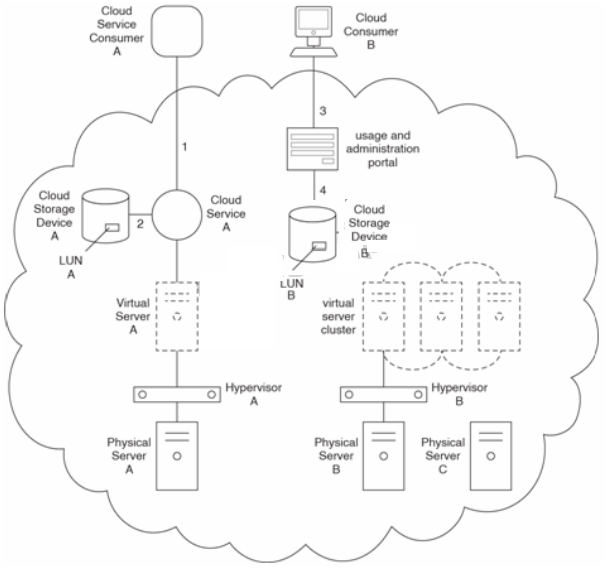Arcitura Education Exam C90.06 Topic 1 Question 4 Discussion
Topic #: 1
Cloud Service A accesses LUN Aon Cloud Storage Device A when it receives requests to process data from cloud consumers. Cloud Service A is hosted by Virtual Server A. The usage and administration portal can be used to access and manage the data in Cloud Storage Device B, which is also hosted by Virtual Server A. Virtual Server A is further hosted by Hypervisor A, which resides on Physical Server A. Virtual Server B is part of a virtual server cluster hosted by Hypervisor B. which resides on Physical Server B. Physical Server C is not in use and does not yet have an operating system installed.
Cloud Service Consumer A sends a request to Cloud Service A (1), which accesses data in LUN Aon Cloud Storage Device A (2). Cloud Consumer B uses the usage and administration portal to upload new data (3). The data is placed in LUN B on Cloud Storage Device B (4).
Cloud Service Consumer A and Cloud Consumer B belong to Organization A, which is leasing Virtual Server A and Virtual Server B from the cloud provider. Organization A also proceeds to lease Physical Server C as part of a new laaS agreement it signs with the cloud provider.
Organization A wants to provision Physical Server C with a number of legacy systems that cannot be deployed on virtual servers. However, when it attempts to do so, it realizes that its laaS package only provides Physical Server C as an out-of-the-box hardware server without anything installed on it. In order to deploy its legacy systems Organization A requires that Physical Server C first has an operating system installed, but it has no means of remotely provisioning Physical Server C with an operating system.

Organization A would like to deploy two of its legacy systems on Virtual Server A and to further extend Cloud Service A's functions so that it can be used as an external interface for cloud service consumers to access legacy system features. Additionally, Organization A would like to deploy three of its mission-critical legacy systems on Virtual Server B in order to take advantage of the additional performance and failover benefits provided by the virtual server cluster that Virtual Server B is part of. Each of the five legacy systems is comprised of dozens of components that need to be installed individually. Instead of manually installing each component of each legacy system, Organization A would like to customize workflows that can automate these deployment tasks.
During the first few months of working with its cloud-based legacy systems. Organization A receives a number of complaints from users that the cloud-based legacy systems are at times behaving erratically. However, when cloud resource administrators with Organization A review the cloud provider's reports that log usage, downtime and other runtime characteristics, they do not find any indication of erratic behavior or any other comparable problems. After some further investigation, the cloud resource administrators determine that the nature of the erratic behavior is specific to proprietary features of the legacy systems and is therefore not monitored or logged by the cloud provider's standard audit monitor, pay-per-use monitor or automated scaling listener.
The cloud resource administrators recommend that a new service agent be developed with features customized to monitor the legacy systems.
Which of the following statements provides a solution that can address Organization A's requirements?
Currently there are no comments in this discussion, be the first to comment!